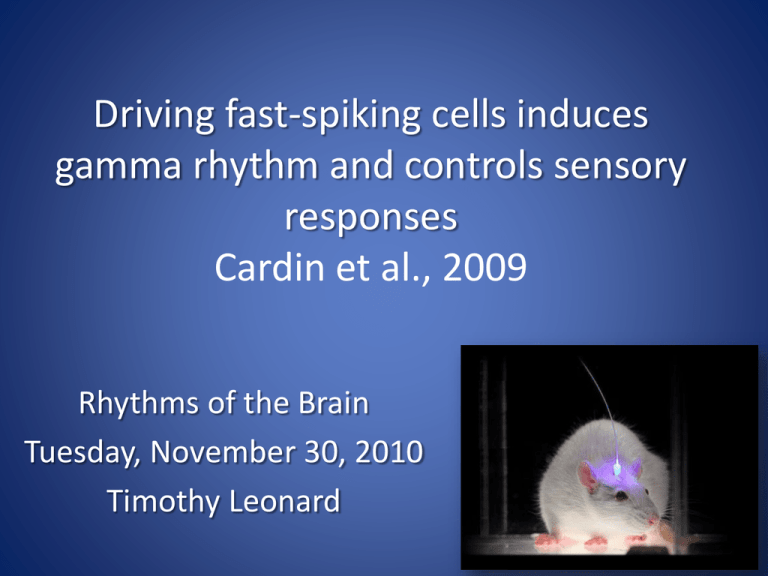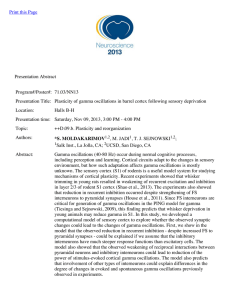Driving fast-spiking cells induces gamma rhythm and controls
advertisement

Driving fast-spiking cells induces gamma rhythm and controls sensory responses Cardin et al., 2009 Rhythms of the Brain Tuesday, November 30, 2010 Timothy Leonard Background/Theory The gamma cycle (Fries, Nikolic, & Singer, 2007) 1. rhythmic network inhibition interacts with excitatory input to pyramidal cells 2. amplitude values converted into phase values • in the gamma cycle more excited cells fire earlier 3. Functional Consequences • enables fast processing and readout – – ‘winner take all’ algorithm coincidence detection, rather than rate integration 1) The process is as follows: • Big Picture: After excitatory input, the network of inhibitory interneurons generates rhythmic synchronized activity and imposes rhythmic inhibition onto the entire local network. • Pyramidal cells will be able to respond to excitatory input only during the time window of fading inhibition. • Pyramidal cells provide the major excitatory drive to the interneurons • interneurons discharge with some phase delay relative to the pyramidal cells • resulting network inhibition terminates the firing of both the pyramidal cells and the interneurons. • The whole network is inhibited and the next gamma cycle starts anew. Taken from Fries, Nikolic, & Singer, 2007 ^ area is important for next slide 2) Conversion of excitatory drive into relative spike timing • If all pyramidal cells receive a similar amount of phasic inhibition – pyramidal cells receiving the strongest excitatory drive will fire first during the phase of the cycle Recoding Excitatory Drive into Relative Spike Timing Excitatory Drive Level of Inhibition Time +++++ + +++ Early in phase, Inhibition at highest Summary 1. rhythmic network inhibition interacts with excitatory input to pyramidal cells 2. amplitude values converted into phase values – in the gamma cycle more excited cells fire earlier Investigating the Gamma Oscillation with Optogenetics • Cardin et al. 2009 – an overview – Tested barrel cortex in mice in vivo • processes information from the rodent whiskers • Primary sensory area (S1) • Detailed & orderly, equivalent to fingers on the hand – high acuity – Light-driven activation of interneurons & pyramidal neurons. • Electrophysiological recordings – Relevant Findings • Integral role of fast spiking interneurons in gamma oscillations • Evidence of amplitude to spike timing recoding Optogenetics Brief • Light-sensitive ChR2 – activated by ~470 nm blue light • Interneurons – targeted to FS-PV+ interneurons • Fast Spiking • Parvalbumin expressed only in IN • Excitatory neurons – Targeted to αCamKII • Expressed only in EX ChR2: bacteriorhodopsin Chlamydomonas reinhardtii channelrhodopsin-2 ( FS-PV+: parvalbumin-positive fast-spiking ChR2-mCherry: AAV DIO ChR2-mCherry Findings Fast Spike activation generates gamma oscillations There should be a selective peak in LFP when FS cells are driven in the gamma range. – 20-80 Hz (optical stimulation) of FS cells resulted in significant amplification of LFP power in that same frequency band – 8-24 (optical stimulation) Hz activation of RS cells resulted in significant amplification of LFP power in that same frequency band – Gamma by FS - lower frequencies by RS • no effect on LFP power when – FS cells at 8 Hz (optical stimulation) – RS stimulation at 40 Hz (optical stimulation) And LFP band Natural gamma oscillations require FS activity • Single light pulses during epochs of natural and evoked gamma Shifted the phase of gamma oscillations that were 1. 2. spontaneously occurring evoked by midbrain reticular formation stimulation – activation by the light pulse significantly increased the duration of the ongoing gamma cycle – Oscillations largely eliminated by blocking AMPA and NMDA receptors despite high levels of evoked FS FS stimulation during naturally occurring gamma • Increased duration of the ongoing gamma cycle Evoked gamma phase regulates sensory processing • Synaptic inputs arriving at peak of inhibition – Should have diminished response • Inputs arriving at the opposite phase in gamma – Should have large response. To test : • Stimulated FS cells at 40 Hz to establish gamma • recorded the responses of RS cells to a single whisker deflection • Deflection presented at one of five phases relative to a single gamma cycle • Timing of whisker-induced RS action potentials relative to lightevoked inhibition and the gamma cycle had a significant impact on – Amplitude – Timing – precision of the sensory-evoked responses of RS cells Evoked gamma phase regulates sensory processing • Gamma oscillations decreased the amplitude of the RS sensory response at three phase points – consistent with the enhanced level of overall inhibition in this state • Precision of sensory-evoked spikes was significantly enhanced in a gamma-phase dependent manner Conclusions • Data directly support the fast-spiking-gamma hypothesis • Provides the first causal evidence that distinct network activity states can be induced in vivo by cell-type-specific activation – first causal demonstration of cortical oscillations induced by cell-type-specific activation • Demonstrates gated sensory processing in a temporally specific manner References Cardin, J. A., Carlen, M., Meletis, K., Knoblich, U., Zhang, F., Deisseroth, K., et al. (2009). Driving fast-spiking cells induces gamma rhythm and controls sensory responses. Nature, 459(7247), 663-667. Fries, P., Nikolic, D., & Singer, W. (2007). The gamma cycle. Trends in Neurosciences, 30(7), 309-316. Optogenetics More Detail • Light-sensitive ChR2 – Cre-dependent expression of ChR2 • ChR2-mCherry – activated by ~470 nm blue light • Interneurons – targeted to FS-PV+ interneurons • Fast Spiking • Parvalbumin expressed only in IN – Injected into PV-Cre knock-in mice – PV-Cre/FS mice • Excitatory neurons – Injected into αCamKII-Cre mice – inducing recombination in excitatory neurons – αCamKII-Cre/RS mice ChR2: bacteriorhodopsin Chlamydomonas reinhardtii channelrhodopsin-2 ( FS-PV+: parvalbumin-positive fast-spiking ChR2-mCherry: AAV DIO ChR2-mCherry









